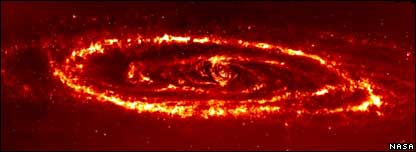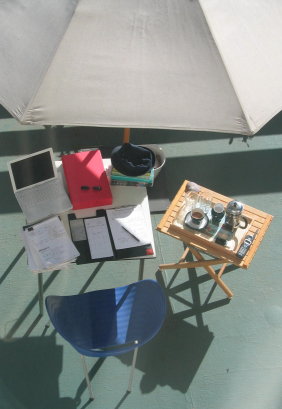I’d Like To Go South Please… Now.
’m watching my email for an invitation to fly suddenly to the Southern Hemisphere. Perhaps the Latin American Summer School (being held in Argentina this year) needs an emergency strings lecturer? I’ll be happy to reprise my lectures from the one I taught at in Mexico city in 2000…
Why do I want to go South with such urgency? This is largely because Comet McNaught continues to put on a wonderful show in the Southern Hemisphere. Amara Graps has kindly put several links for us to look at in the comment stream of my Look Up Down South post. Have a look here, here, here, here, and here. I did, and I found this lovely shot (by Mary Fanner – click for larger) of the comet over the beautiful city of Cape Town, which I miss a lot from the days when I helped run the ASTI science education program in 2004:
There are several more to be found on […] Click to continue reading this post



 So imagine that you’re standing at some spot, holding a big round bulb that can shine in all directions. At a particular time, you switch on the bulb and it shines out brightly. Who has a chance to see the light from your bulb? Let’s not worry about things like buildings, cars, etc., getting in the way of the light, but just imagine it can shine free in all directions. You’ll realize that there is a whole ball of light expanding away from the bulb – light going away from you in all directions. (The edge of that ball describes what is called a sphere, a two-sphere to be precise, denoted [tex]S^2[/tex] in the trade.) The sphere expands at the speed of light. You might imagine that eventually every point in space around you would be reached by your expanding sphere (let’s stay local and not worry about the expanding universe and so forth), and you’d be right. But when? When does it get to some particular point that you might care about? As soon as it takes the light the time it takes to get there, of course. It can’t get there any sooner than that.
So imagine that you’re standing at some spot, holding a big round bulb that can shine in all directions. At a particular time, you switch on the bulb and it shines out brightly. Who has a chance to see the light from your bulb? Let’s not worry about things like buildings, cars, etc., getting in the way of the light, but just imagine it can shine free in all directions. You’ll realize that there is a whole ball of light expanding away from the bulb – light going away from you in all directions. (The edge of that ball describes what is called a sphere, a two-sphere to be precise, denoted [tex]S^2[/tex] in the trade.) The sphere expands at the speed of light. You might imagine that eventually every point in space around you would be reached by your expanding sphere (let’s stay local and not worry about the expanding universe and so forth), and you’d be right. But when? When does it get to some particular point that you might care about? As soon as it takes the light the time it takes to get there, of course. It can’t get there any sooner than that. 
 EDGE here stands for “Evolutionarily Distinct and Globally Endangered” and is a term that was coined to refer specifically to certain threatened species of animal around the world. They’re not always your big marquee animals (Lions and Tigers and Bears! Oh My!), and a great deal of them will be unfamiliar to you. (I’d never encountered the Golden-Rumped Elephant Shrew before, and I’ll admit that my life has been all the poorer for not having known about it before. It’s so cute! Furthermore, it has a golden rump. What’s not to like? Apparently, it is related to an elephant, somewhat distantly. Yes, it has a trunk, but it takes more than that to detemine its relationship to elephants! Update: – Here’s a Wikipedia article on elephant shrews, which could be a starting point for finding out more. The EDGE site has a lot of information too: here.
EDGE here stands for “Evolutionarily Distinct and Globally Endangered” and is a term that was coined to refer specifically to certain threatened species of animal around the world. They’re not always your big marquee animals (Lions and Tigers and Bears! Oh My!), and a great deal of them will be unfamiliar to you. (I’d never encountered the Golden-Rumped Elephant Shrew before, and I’ll admit that my life has been all the poorer for not having known about it before. It’s so cute! Furthermore, it has a golden rump. What’s not to like? Apparently, it is related to an elephant, somewhat distantly. Yes, it has a trunk, but it takes more than that to detemine its relationship to elephants! Update: – Here’s a Wikipedia article on elephant shrews, which could be a starting point for finding out more. The EDGE site has a lot of information too: here. The Andromeda Galaxy is bigger than previously thought. Perhaps as much as five times bigger. I know that you’re thinking – “Oh, that’s because most of it is dark matter, right?” No, this is not another dark matter story. In fact, there are many newly discovered stars from a recent study! The suburbs of the galaxy are much more extensive than previously identified. It’s rather good news, since the galaxy makes more sense than it did before, in the context of our understanding of how galaxies form and evolve. (Image above is of Andromeda in the infra-red, from NASA.)
The Andromeda Galaxy is bigger than previously thought. Perhaps as much as five times bigger. I know that you’re thinking – “Oh, that’s because most of it is dark matter, right?” No, this is not another dark matter story. In fact, there are many newly discovered stars from a recent study! The suburbs of the galaxy are much more extensive than previously identified. It’s rather good news, since the galaxy makes more sense than it did before, in the context of our understanding of how galaxies form and evolve. (Image above is of Andromeda in the infra-red, from NASA.)


